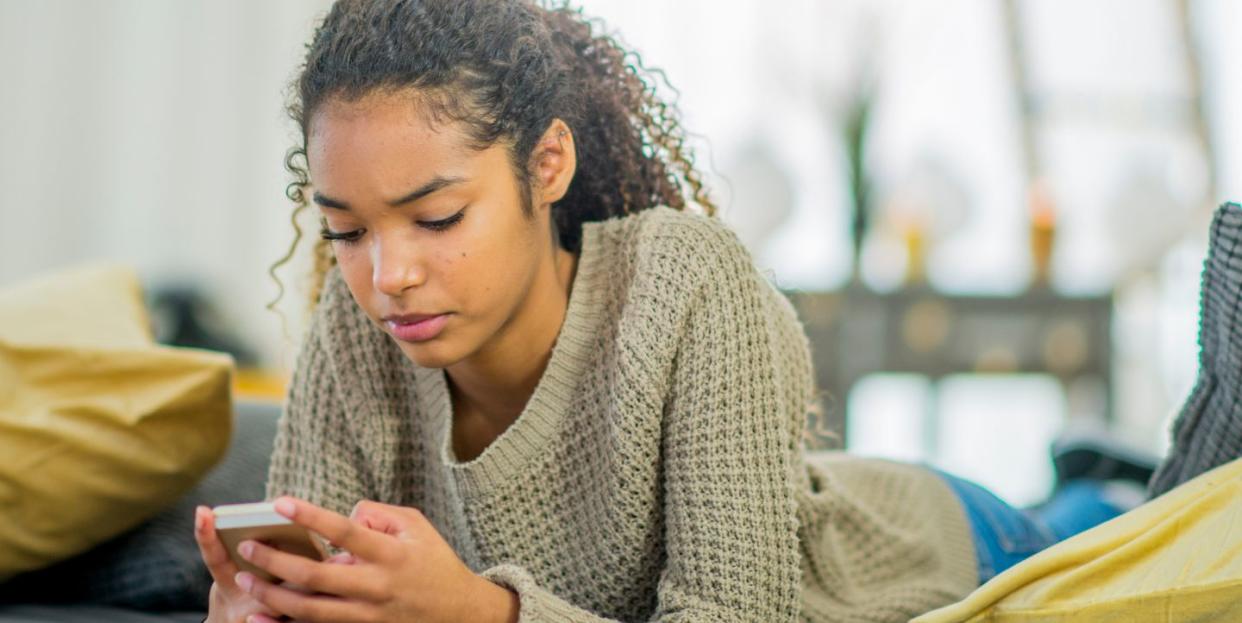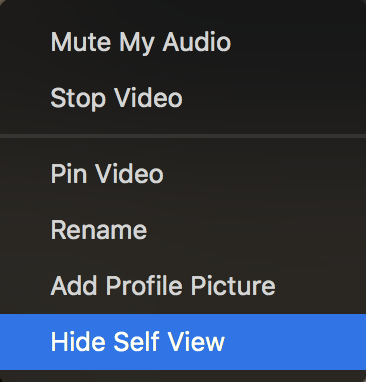How Isolating in Quarantine Has Been Detrimental To Our Body Image

Over the past seven months, the new world of quarantine and self-isolation has left us looking for distractions. We baked. We watched Tiger King. We threw on chunky knit sweaters in the name of folklore. Throughout the uncertainty of the coronavirus and navigating life in a global pandemic, though, there has been one consistency—spending hours alone, often using TikTok and social media to pass the time. It seemed like a harmless diversion at first, one that kept us occupied whether we were trying to fall asleep or couldn't seem to sleep at all. But more than half a year in, it's become apparent that this new world—one that is keeping us safe—has proven to be detrimental to those suffering with mental health disorders.
Since March, states across the country have imposed shelter-in-place requirements, asking citizens to stay at home as much as possible in order to stop the spread of the coronavirus. While a necessary precaution, the sad reality is that doing this creates an environment in which mental health disorders can thrive, especially those related to body image and disordered eating. A study conducted at San Diego State University and Florida State University found that in April, one in four Americans met criteria that would classify them as suffering with "serious mental distress." That's eight times as many as in 2018. A different study from wellbeings.org and PBS NewsHour Student Reporting Labs found that of 1,000 people interviewed between the ages of 16 and 19, more than half said that the pandemic has made their mental health either much worse or somewhat worse.
Celeste Smith, a certified eating disorder specialist and licensed marriage and family therapist, saw this first hand. It was around April or May when she says her phone began ringing off the hook with patients reaching out for care. While Smith treats a variety of mental health illnesses, it was her patients that suffer from eating disorders that seemed to be reaching out with the most frequency. "I've had clients that have been in recovery for years that were doing very well," she said. "Now, they're coming back to therapy and recovery after a lapse due to the conditions of COVID."
Our Body Image and Quarantine
At the start of 2020, Mary, a 21-year-old at Fordham University, felt like she had a handle on her disorders, at least the anorexia nervosa and bulimia that plagued her in the past. Then came the coronavirus in March, and the 21-year-old found herself quarantining with her family in Ohio.
"It was definitely an eye opener for me to realize that you can think you're getting better, but something like this happens and then you're like, 'Oh, maybe I'm not doing as well as I thought I was.'"
According to National Eating Disorders Association anorexia nervosa is characterized by symptoms like weight loss, food restriction, and often a distorted body image. Bulimia, meanwhile, involves "a cycle of bingeing and compensatory behaviors such as self-induced vomiting." But there are many other body disorders that affect millions of Americans and when Mary was with her family, it was orthorexia that became an issue. Orthorexia is defined as an obsession with "healthful" eating to the point that it damages your wellbeing. When you're surrounded by other people, though, this disorder is easier to hide since it can more easily be disguised as "healthy living."
Then, when Mary left home in August to return to the Bronx for school, she found herself alone in her apartment and her recovery progress regressing more intensely.
"Eating disorders thrive in isolation," she explained. In fact, she described the environment of quarantine as the perfect habitat for an eating disorder to run rampant. Without going out to dinner with friends, she could be very picky about the food she ate. And instead of physically going to the grocery store, she opted to get her food delivered, allowing her to be more discreet with her purchases.
A common sign of anorexia nervosa is someone isolating themselves, especially around mealtime. But Mary had no one to isolate from, and she found herself drifting back into old habits. "It's a perfect condition for an eating disorder to just grow, because there's no accountability," Smith said.
Being isolated isn't the only trigger for these disorders. The issue also comes from what we are consuming and engaging with when we find ourselves alone for hours at a time. "There's this idea that we're all supposed to come out on top, that somehow if we don't come out of COVID with a cleaner house, less clutter, some new skill, that we're failing at life," Smith said.
In the first month or so of quarantine, social media became a showcase for those learning new skills and taking on new projects. It suddenly became a competition for progress, and while the world around us was crumbling, we had to be improving.
Mary felt that pressure. Her first COVID project was learning to do a split, and she quickly moved on from there. "I then started doing 100 squats a day because a girl on TikTok was like, 'I'm doing this, it's so easy. Just try.'" Mary admits that keeping up with the workout made her feel good, but the videos she was watching on the app lead her down an algorithmic hole of fitness TikTok. "I've always been relatively active," she said. "I was not pushing myself too much, but those are things that were constantly facing me and I was innocently enough engaging with them."
Suddenly, the language changed and social media moved on from productivity to the fear of weight gain. People began to use the term Quarantine 15 or the COVID 19, referring to the weight they were gaining during the pandemic. On this topic, Lauren Muhlheim, author of When Your Teen Has an Eating Disorder: Practical Strategies to Help Your Teen Recover from Anorexia, Bulimia, and Binge Eating reminded USA Today of this: "Eating during a pandemic is normal and gaining weight during a pandemic is fine."
Even still, videos of girls sharing how they're avoiding weight gain started popping up on Mary's TikTok. And in the midst of those "What I Eat in a Day" videos, came some that Mary wished never appeared on her "For You Page."
"I have a specific memory of the first time I saw a video about eating disorders on TikTok." For Mary, this was concerning. While she has gone through therapy and has learned ways to deal with her disorders, she recognized that there are people who don't have those coping skills and seeing those videos "could really mess them up."
Regardless of what's appearing on your "For You Page," you're still seeing dancing videos and shareable memes that the platform has become known for. Just like with Instagram, many of these videos show an idealized life, complete with the "perfect" body, relationship, or job. Lives that might make your feel less than in comparison. In the wellbeings.com study referenced above, 44.4% of respondents said that social media had a negative effect on their day-to-day mental health.
This all comes as TikTok continues to grow in popularity. As of July 2020, the app has over 800 million monthly users and 41% of them are between the ages of 16 and 24. Professor Heather Widdows from the University of Birmingham explained the increased use of social media during this time as people looking to it as "a life line of connectivity."
"It's the only way that a lot of interaction has happened so the dominance of it increases as does the need to be liked and be acknowledged on it because you're not being acknowledged in other ways," she explained.
Claire Mysko, CEO of the National Eating Disorder Association, suggests being a bit more selective online. "We recommend that people with eating disorders be very intentional about who they follow on social media and not engage with those who can be triggers,” she told Healthline.
Smith agrees: hit that unfollow button. "Then, you don't have to see things you don't want to see," she said. "Instead, you can follow some people that might be really great for your recovery." As for TikTok, stick to your following feed, and give up on the "For You Page" if it's showcasing triggering content.
Facing Ourselves on Video
In our new world, video calls have replaced in-person activities and that hasn't come without consequences either.
"We're not used to seeing our faces in motion all the time," said Professor Widdows. "Normally, we get up in the morning, do a quick ten minutes in the mirror and dash off to go about our day." While we used to use our front-facing camera to make sure there's nothing on our face, now we are constantly looking at ourselves.
A video call is not like looking in the mirror, warns Professor Widdows. These calls produce a two-dimensional picture, unlike the three dimensional one you see in your reflection, making the image more artificial. There's also that fact that when you're looking in the mirror, most of the time, you're trying to look good. You're posing, smiling, showing off your good side. But when you're having a conversation with someone on a video call—be it Zoom, FaceTime, or any other app—you're not focused on the way you look, you're focused on engaging with a person. So, if you catch yourself in the corner of your eye while presenting your history project to the class, it may not feel like the most flattering moment.
Learning How to Adapt
It's unrealistic to think that we can avoid these new parts of our daily life, but luckily, the world is adapting. If you can't bare to see yourself on video all day and you find yourself picking out your flaws instead of actually paying attention to the lecture, hide yourself on the app. Click on those three little buttons near where you face appears on video calls and choose the "Hide Myself" option. Everyone else will still be able to see you, and your teacher will know that you're there, but you won't have to look at yourself throughout math class, and it will feel more like an authentic learning experience. If the platform you're using doesn't have that option, Smith suggests placing a sticky note over your view.

Therapy has adapted too. Now, in the wake of the pandemic, many therapists are moving their practices online, meaning getting help has become easier than ever. If you find yourself struggling in anyway during this time, speaking to a professional could help. Companies like BetterHelp and TalkSpace will match you with a counselor who you can talk to without having to leave your quarantine bubble.
And while there is no need to gain a hobby in quarantine (no matter what TikTok tells you), finding something that relaxes you can be a good way to cope with a disorder that has been heightened by the environment. Mary recently began bullet journaling and drawing. "It something that distracts me," she said.
Yes, we are all spending more time alone these days, and it's easy to feel isolated when your only form of interaction is across a computer or phone screen. But you are not alone in that feeling, and you are definitely not alone when it comes to the negative impact it may be having on you. "We don't need to experience this great improvement or achievement," Smith said. Right now, it's enough just to wake up everyday and move forward in this pandemic.
If you or someone you know is suffering from an eating disorder, please call the National Easting Disorders Association's hotline at 800-931-2237 or visit their website.
You Might Also Like

